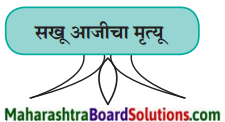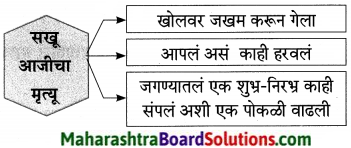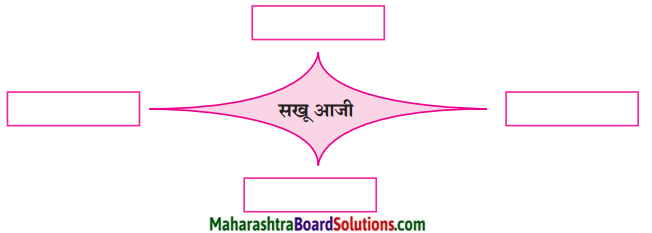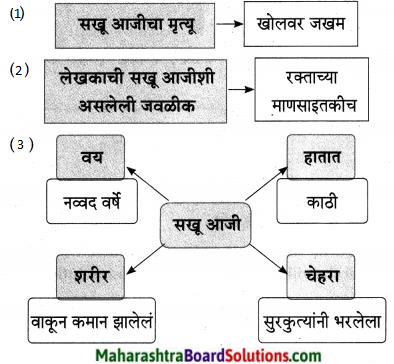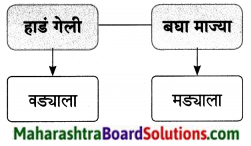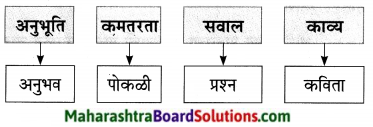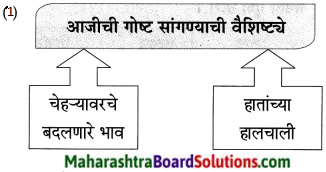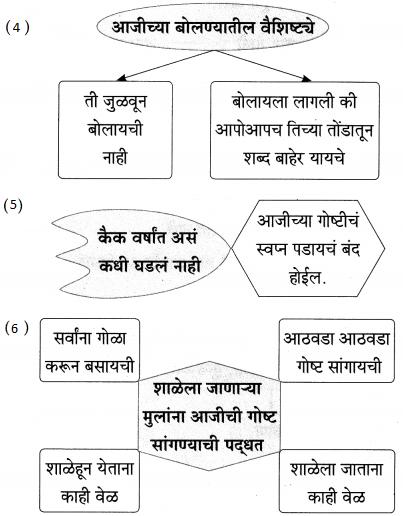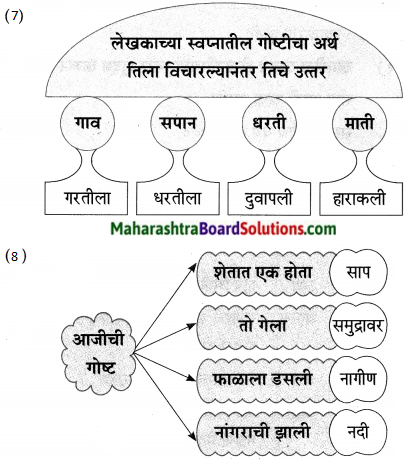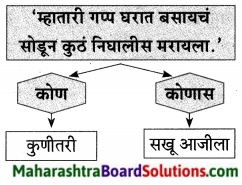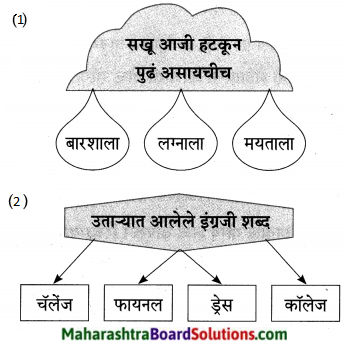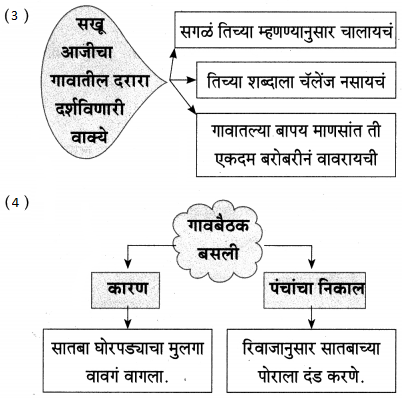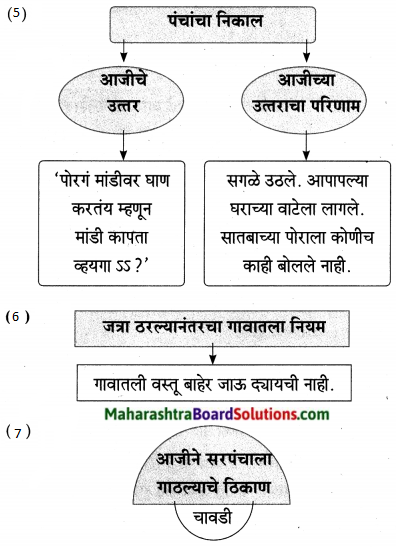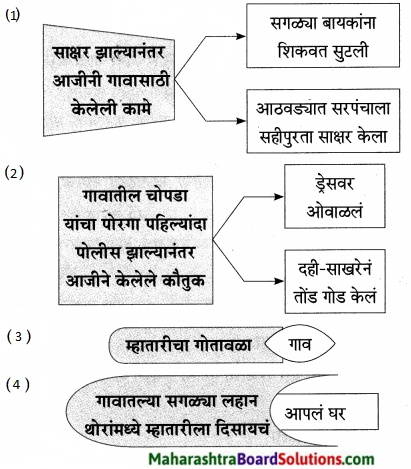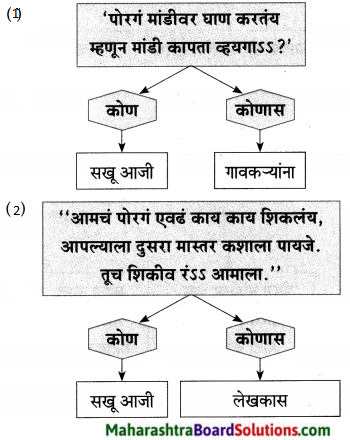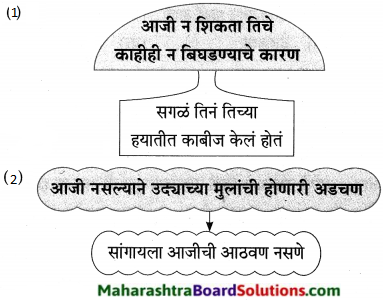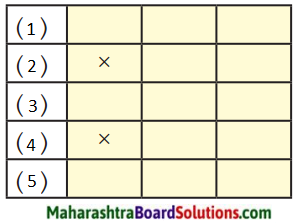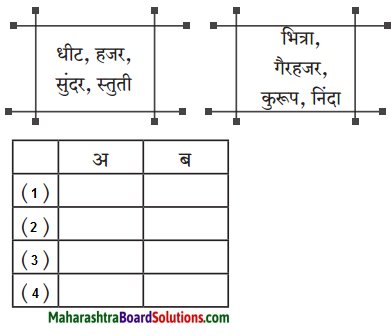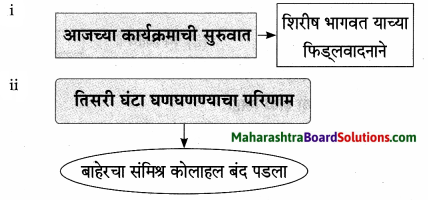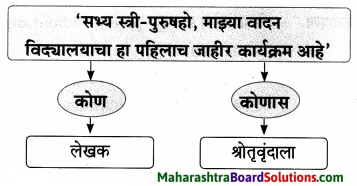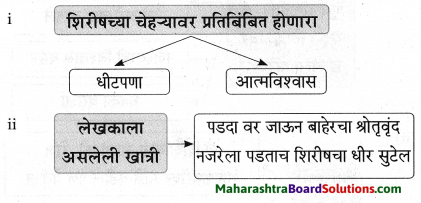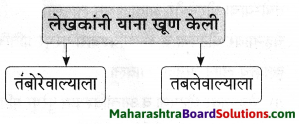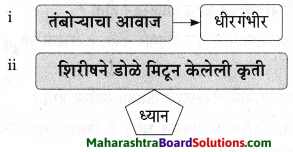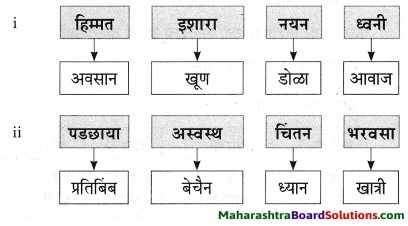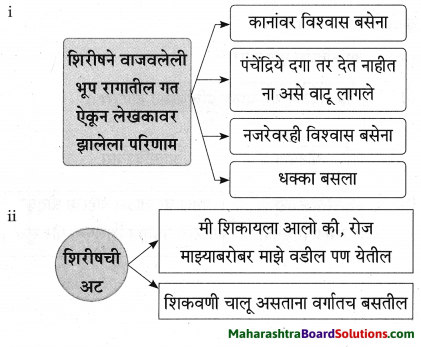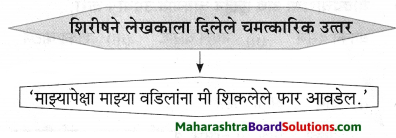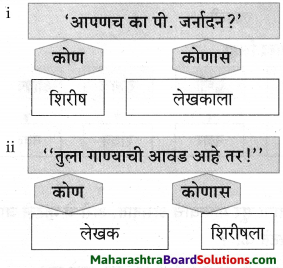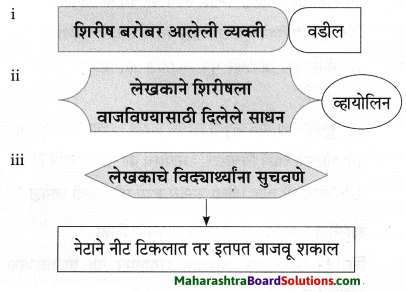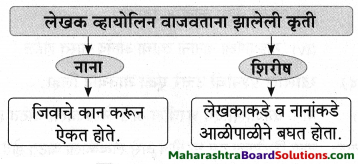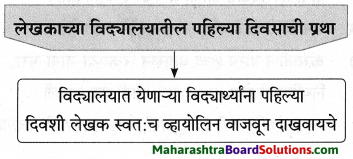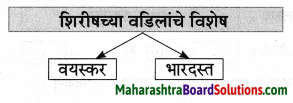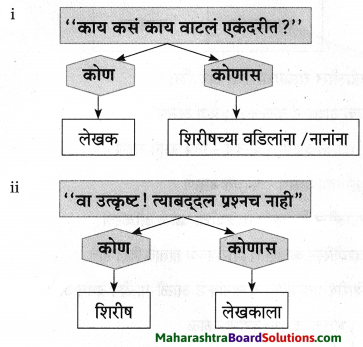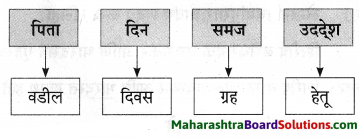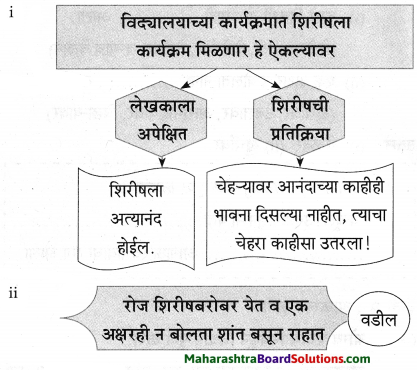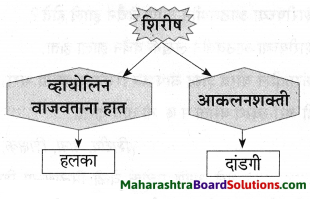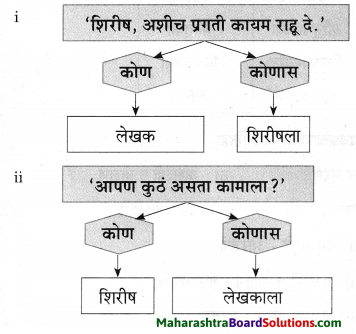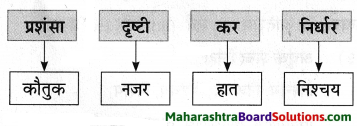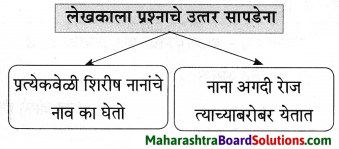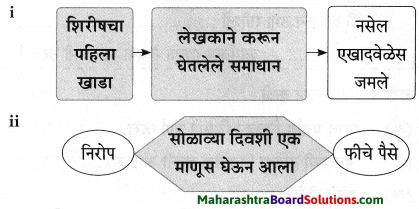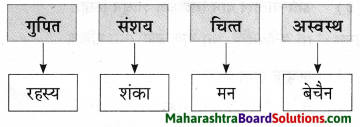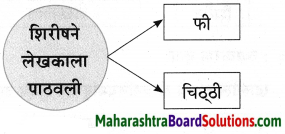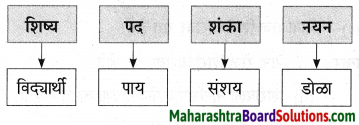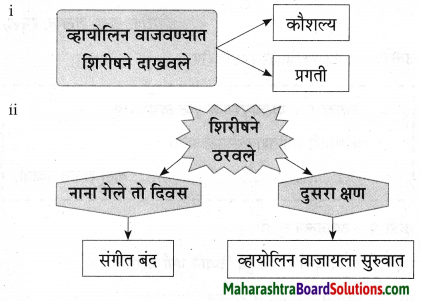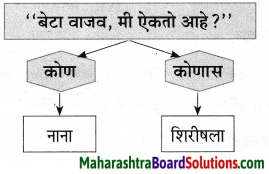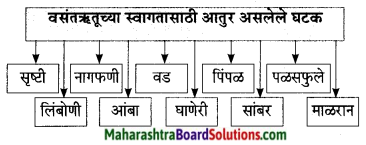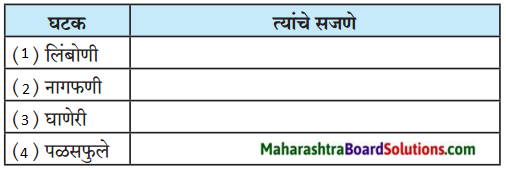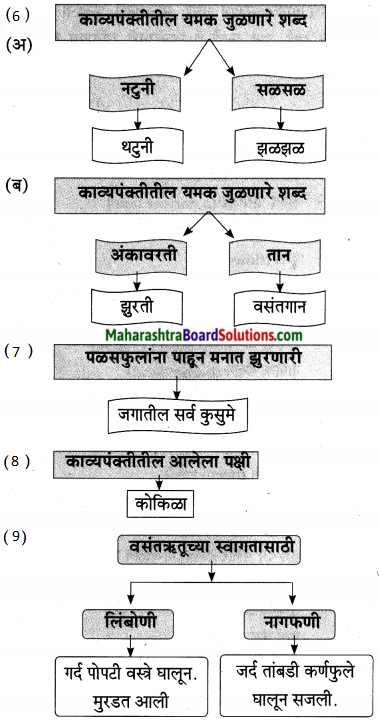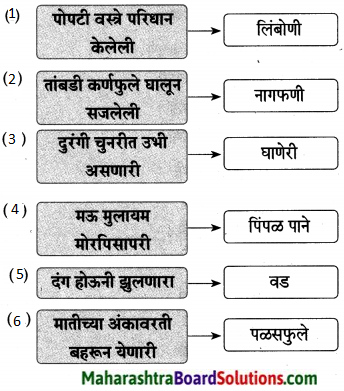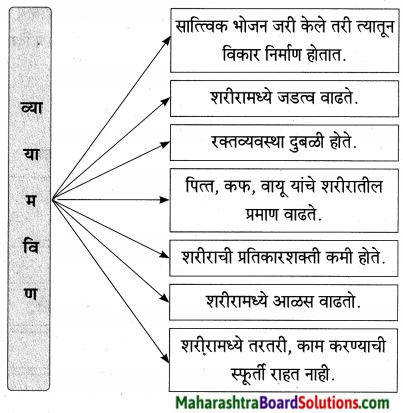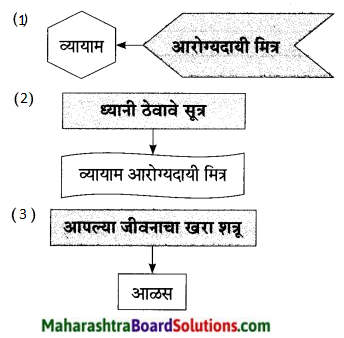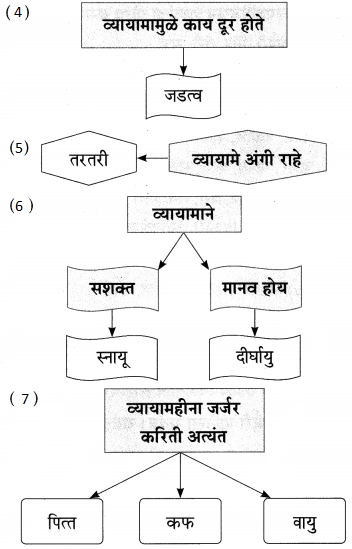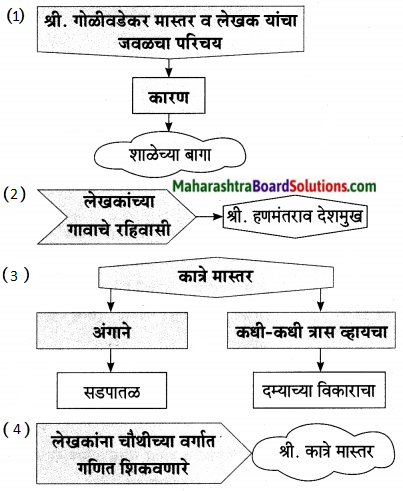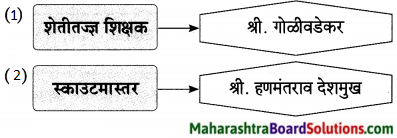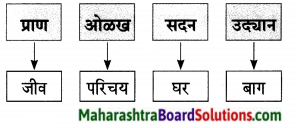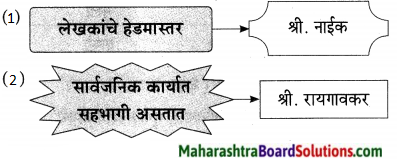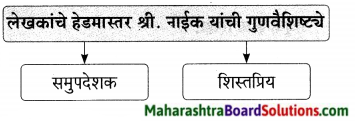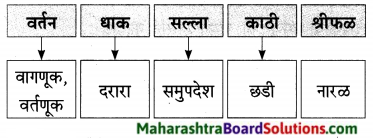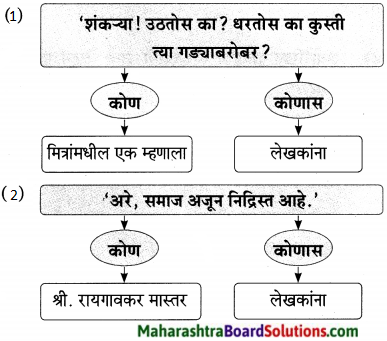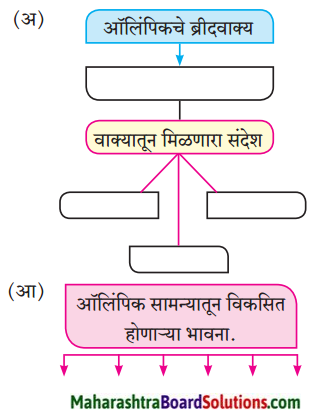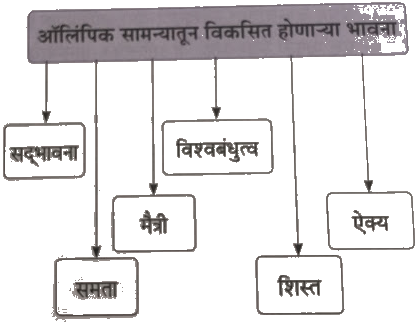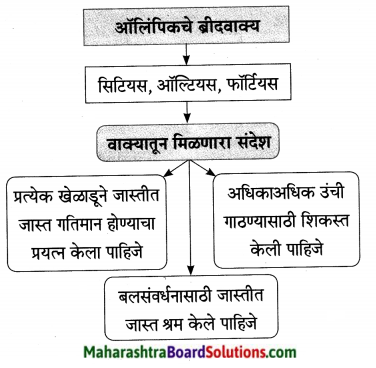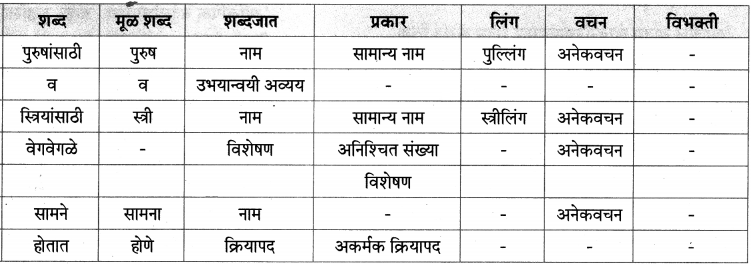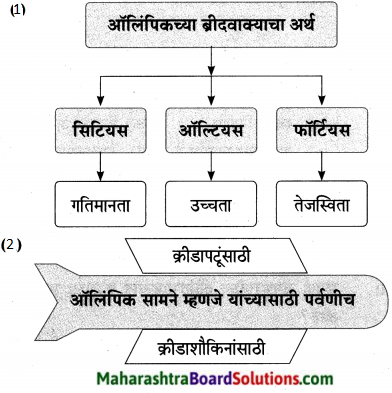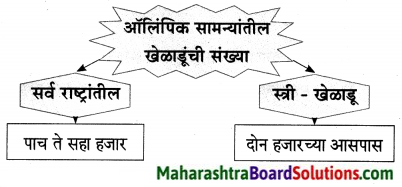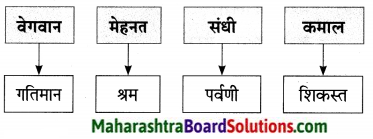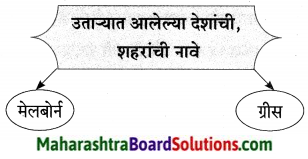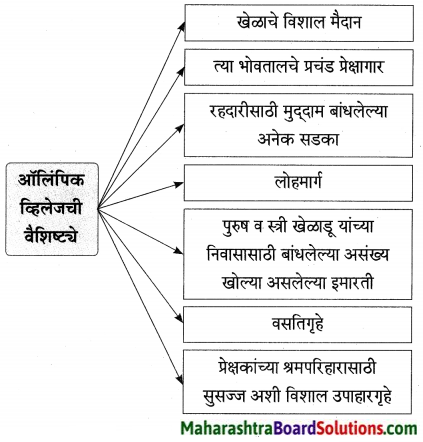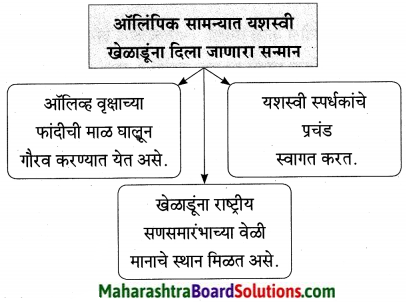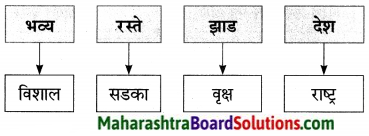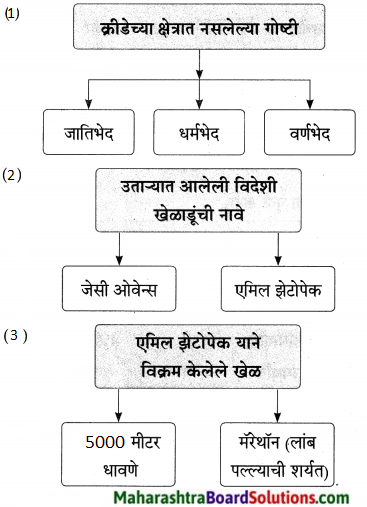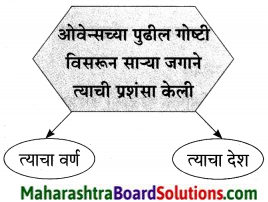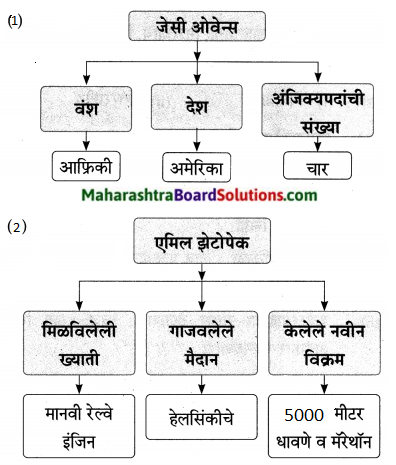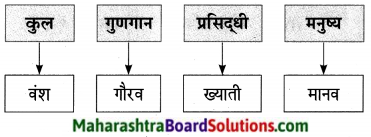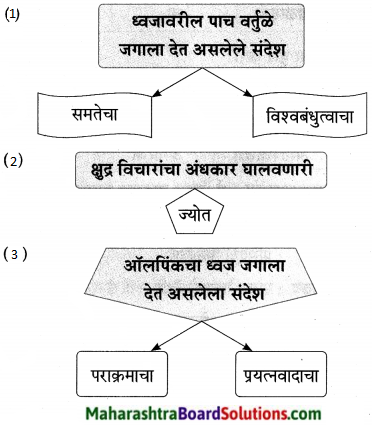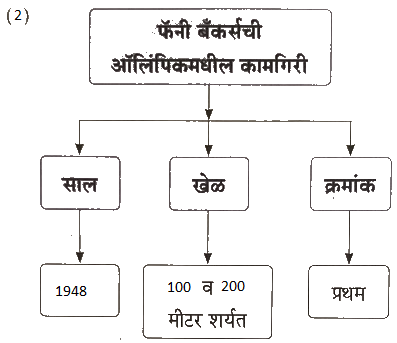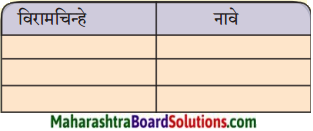Balbharti Maharashtra State Board Class 9 Marathi Solutions Aksharbharati Chapter 11 आभाळातल्या पाऊलवाटा Notes, Textbook Exercise Important Questions and Answers.
Class 9 Marathi Aksharbharati Chapter 11 आभाळातल्या पाऊलवाटा Question Answer Maharashtra Board
आभाळातल्या पाऊलवाटा Std 9 Marathi Chapter 11 Questions and Answers
1. प्रश्न (अ)
पक्षी स्थलांतराच्या अभ्यासाच्या वाळे अडकविण्याच्या पद्धतीचा घटनाक्रम लिहा.

उत्तर:
- एखाद्या विशिष्ट भागातील पक्षी पकडणे.
- त्यांच्या पायात खुणेचे वाळे अडकवणे.
- कोणत्या क्रमांकाचे वाळे कोणत्या पक्ष्याला, कुठे आणि – केव्हा लावले याची संस्थेकडे नोंद करणे.
- वाळे अडकवलेले पक्षी पुन्हा मोकळे सोडणे.
![]()
प्रश्न (आ)
पक्ष्यांच्या स्थलांतराची वैशिष्ट्ये लिहा.

उत्तरः
- पक्षी हजारो मैलांचा प्रवास करतात.
- अन्नाचे दुर्भिक्ष हे पक्ष्यांच्या स्थलांतरामागची मूळ प्रेरणा आहे.
- पक्षी थंडीत खाली दरीत अथवा सखल भागात उतरतात.
- उन्हाळ्यात परत वर सरकतात.
प्रश्न (इ)
स्थलांतर करणाऱ्या वेगवेगळ्या जातींतील पक्ष्यांचे साम्यघटक लिहा.

उत्तरः
- पक्षी नियमित स्थलांतर करतात.
- धार्मिक विधी असल्यासारखा स्थलांतर हा त्यांच्या जीवनाचा भाग झाला आहे.
- एका जातीचे अनेक पक्षी एकत्र येतात.
- पक्षी ठराविक मुहूर्ताला प्रयाण करतात.
2. फरक स्पष्ट करा.
प्रश्न 1.
फरक स्पष्ट करा.

उत्तरः
| दक्षिणेकडील हवामान | उत्तरेकडील हवामान |
| 1. उष्ण | 1. थंड |
| 2. हवेची घनता जास्त | 2. हवेची घनता कमी |
![]()
3. चौकटी पूर्ण करा.
प्रश्न 1.
चौकटी पूर्ण करा.
- पक्ष्यांच्या स्थलांतराची मूळ प्रेरणा – [ ] [ ]
- बलाकांचे भारतात स्थलांतर होणारे देश – [ ] [ ]
- आधुनिक काळात पक्ष्यांच्या स्थलांतराची माहिती देणाऱ्या गोष्टी – [ ] [ ]
- गिर्यारोहकांच्या मागे जाणारे पक्षी – [ ] [ ]
उत्तर:
- अन्नाचे दुर्भिक्ष
- जर्मनी, सायबेरिया
- विमाने, रडारयंत्रणा
- हिमकाक पक्षी
4. कारणे लिहा.
प्रश्न 1.
कारणे लिहा.
1. फक्त अल्युमिनिअमचेच वाळे पक्ष्यांच्या पायात अडकवतात कारण …..
2. हिवाळ्यात पक्षी दक्षिणेकडे स्थलांतर करतात कारण ……
उत्तर:
1. फक्तअल्युमिनिअमचेच वाळे पक्ष्यांच्या पायातअडकवतात कारण हे वाळे हलके असतात.
2. हिवाळ्यात पक्षी दक्षिणकडे स्थलांतर करतात कारण बर्फ पडून अन्न शोधणे कठीण होते.
5. सूचनेप्रमाणे कृती करा.
प्रश्न 1.
पक्ष्यांना भविष्याची चाहूल लागते. (या अर्थाचे वाक्य शोधा.)
उत्तरः
सूर्य दक्षिणेकडे झुकू लागला, की त्यांचे मन जणू उचल खाते.
प्रश्न 2.
जर्मनी आणि सायबेरिया हे उत्तर येईल असा प्रश्न तयार करा.
उत्तर:
कोणत्या देशांतून भारतात श्वेतबलाक व बदकांच्या काही जाती येतात?
प्रश्न 3.
वाळे अडकवलेले पक्षी मोकळे सोडले जातात. (अधोरेखित शब्दाचा विरुद्धार्थी शब्द वापरून वाक्य पुन्हा लिहा.)
उत्तरः
वाळे अडकवलेले पक्षी बंदिस्त केले जातात.
![]()
6. स्वमत.
प्रश्न 1.
पक्षी निरीक्षणातून पक्ष्यांच्या जीवनपद्धतीसंबंधी तुमची मते सविस्तर लिहा.
उत्तर:
उतारा 3 मधील कृती 4: स्वमतचे उत्तर पहा.
प्रश्न 2.
तुमच्या मते मानवी जीवन व पक्षी जीवन यांच्यातील
महत्त्वाचे साधर्म्य सोदाहरण लिहा. उत्तरः उतारा ४ मधील कृती ४ : स्वमतचे उत्तर पहा. __ *
7. अभिव्यक्ती.
प्रश्न 1.
‘पक्षी जाय दिगंतरा’ ही उक्ती पाठाच्या आधारे तुमच्या शब्दांत स्पष्ट करा.
उत्तरः
उतारा 1 मधील कृती 4 : स्वमतचे उत्तर पहा.
प्रश्न 2.
तुम्हांला पक्षिमित्र बनायला आवडेल काय? तुमचे मत सकारण लिहा.
उत्तरः
उतारा 2 मधील कृती 4: स्वमतचे उत्तर पहा.
Marathi Akshar Bharati Class 9 Textbook Solutions Chapter 11 आभाळातल्या पाऊलवाटा Additional Important Questions and Answers
पुढील उताऱ्याच्या आधारे दिलेल्या सूचनेनुसार कृती करा:
कृती 1: आकलन कृती
प्रश्न 1.
आकृतिबंध पूर्ण करा.
उत्तर:
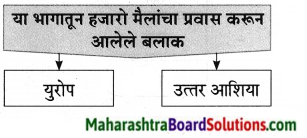
प्रश्न 2.
उत्तर लिहा.
उत्तर:
या देशातून भारतात येणारे श्वेतबलाक → जर्मनी
![]()
प्रश्न 3.
जोड्या जुळवा.
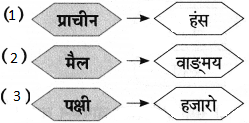
उत्तर:

खालील प्रश्नांची उत्तरे एका वाक्यात लिहा.
प्रश्न 1.
पक्ष्यांच्या बाबतीत सर्वात स्तिमित करणारी गोष्ट कोणती?
उत्तर:
पक्ष्यांच्या बाबतीत सर्वात स्तिमित करणारी गोष्ट म्हणजे काही पक्षी जाती वर्षातून दोनदा करत असलेला हजारो मैलांचा प्रवास.
प्रश्न 2.
भारतात असंख्य जातीचे पक्षी कोणत्या ऋतूच्या आरंभी येऊ लागतात?
उत्तर:
भारतात असंख्य जातीचे पक्षी हिवाळा या ऋतूच्या आरंभी येऊ लागतात.
प्रश्न 3.
पक्ष्यांबद्दलची कोणती माहिती कुठेही दिसत नाही?
उत्तरः
हिवाळ्याच्या आरंभी भारतात येणारे हजारो पक्षी इतर वेळी कुठे जातात, पक्ष्यांबद्दलची ही माहिती कुठेही दिसत नाही.
प्रश्न 4.
कंसातील योग्य शब्द वापरून रिकाम्या जागा भरा.
1. ……….. पक्षीसुद्धा पावसाळ्यात दिसत नाहीत अशी वर्णने प्राचीन वाङमयात आहेत. (फ्लेमिंगो, बदक, हंस, कावळा)
2. बलाकांच्या स्थलांतराविषयी ………….. वाङ्मयात उल्लेख आढळतात. (व्यासाच्या, कालिदासाच्या, वेदाच्या, वशिष्ठाच्या)
उत्तर:
1. हंस
2. कालिदासाच्या
![]()
प्रश्न 5.
सहसंबंध लिहा.
अनियमित : नियमित : : अर्वाचीन : ……………
उत्तर:
प्राचीन
प्रश्न 6.
शब्दसमूहासाठी एक शब्द चौकटीत लिहा.
एका ठिकाणाहून दुसऱ्या ठिकाणी जाणे – [स्थलांतर]
कृती 2: आकलन कृती
प्रश्न 1.
योग्य पर्याय निवडून विधान पूर्ण करा. भारतातल्या कोणत्याही सरोवराकडे हिवाळ्याच्या सुरुवातीला नजर टाकली तर ………
(अ) निरनिराळ्या जातींच्या प्राण्यांनी पाणी अक्षरश: झाकलेले दिसते.
(ब) निरनिराळ्या जातींच्या कीटकांनी पाणी अक्षरश: झाकलेले दिसते.
(क) पाणी अक्षरश: रंगीत दिसते.
(ड) निरनिराळ्या जातींच्या बदकांनी पाणी अक्षरशः झाकलेले दिसते.
उत्तरः
भारतातल्या कोणत्याही सरोवराकडे हिवाळ्याच्या सुरुवातीला नजर टाकली तर निरनिराळ्या जातींच्या बदकांनी पाणी अक्षरश: झाकलेले दिसते.
प्रश्न 2.
कोण ते लिहा.
उत्तरः

प्रश्न 3.
आकृतिबंध पूर्ण करा.
उत्तरः
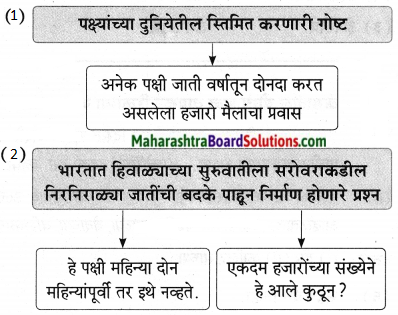
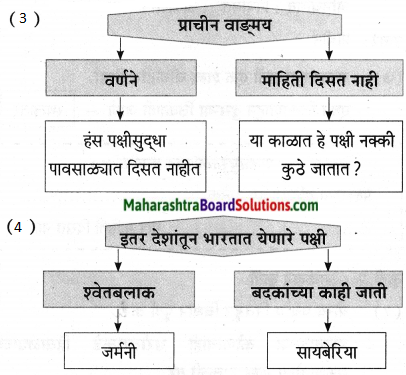
![]()
प्रश्न 4.
सत्य वा असत्य ते लिहा.
1. माणसांच्या दुनियेतल्या अनेक गोष्टी आश्चर्यकारक आहेत.
2. भारतात येणारे श्वेतबलाक ऑस्ट्रेलियातून येतात.
उत्तर:
1. असत्य
2. असत्य
कृती 3: व्याकरण कृती
प्रश्न 1.
खालील वाक्य लेखननियमांनुसार शुद्ध करून लिहा.
हे पक्षि महिन्या दोन महीन्यांपूर्वी तर इथे नव्हते.
उत्तरः
हे पक्षी महिन्या दोन महिन्यांपूर्वी तर इथे नव्हते.
प्रश्न 2.
उताऱ्यातील नामे शोधून लिहा.
उत्तर:
- पक्षी
- सरोवर
- बदक
- पाणी
- युरोप
- आशिया
- भारत
- श्वेतबलाक
- जर्मनी
- सायबेरिया
- बलाक
- कालिदास
- हंस
प्रश्न 3.
अचूक शब्द लिहा.
1. हिवळ्याच्या , हीवाळ्याच्या, हिवाळाच्या, हिवाळ्याच्या
2. स्तीमित, स्मितित, स्तिमित, स्तितिम
उत्तर:
1. हिवाळ्याच्या
2. स्तिमित
![]()
प्रश्न 4.
समानार्थी शब्द लिहा.
उत्तर:
- सुरुवात – [आरंभ]
- पांढरा – [श्वेत]
- खग – [पक्षी]
- दृष्टी – [नजर]
- जल – [पाणी]
प्रश्न 5.
विरुद्धार्थी शब्द लिहा.
उत्तर:
- शेवट × सुरुवात
- उघडे × झाकलेले
- अर्वाचीन × प्राचीन
- काळा × श्वेत
प्रश्न 6.
अधोरेखित शब्दाचा समानार्थी शब्द वापरून वाक्य पुन्हा लिहा.
बगळ्यांच्या स्थलांतराविषयी कालिदासाच्या वाङमयात उल्लेख आढळतात.
उत्तरः
बलाकांच्या स्थलांतराविषयी कालिदासाच्या वाङमयात उल्लेख आढळतात.
प्रश्न 7.
उताऱ्यातील अनेकवचनी शब्द शोधून लिहा.
उत्तर:
- गोष्टी
- जाती
- वर्णने
- पक्षी
प्रश्न 8.
तक्ता पूर्ण करा.
उत्तर:
| शब्द | प्रत्यय | विभक्ती |
| बदकांनी | नी | तृतीया (अनेकवचन) |
| वर्षातून | ऊन | पंचमी (एकवचन) |
| हजारोंच्या | च्या | षष्ठी (अनेकवचन) |
| पक्ष्यांच्या | च्या | षष्ठी (अनेकवचन) |
![]()
प्रश्न 9.
तक्ता पूर्ण करा.
उत्तर:
| शब्द | सामान्यरूप | मूळ शब्द |
| 1. पक्ष्याच्या | पक्ष्या | पक्षी |
| 2. हिवाळ्याच्या | हिवाळ्या | हिवाळा |
| 3. बदकांच्या | बदकां | बदक |
| 4. संख्येने | संख्ये | संख्या |
प्रश्न 10.
वाक्प्रचाराचा अर्थ लिहून वाक्यात उपयोग करा.
स्तिमित करणे
उत्तरः
अर्थ – आश्चर्यचकित करणे.
वाक्य – जादूगाराने आपल्या खेळांतून सर्वांना स्तिमित केले.
प्रश्न 11.
वाक्यातील काळ ओळखा.
भारतात येणारे श्वेतबलाक जर्मनीतून येतात.
उत्तरः
वर्तमानकाळ.
प्रश्न 12.
काळ बदला. (भविष्यकाळ करा)
पक्षी नियमितपणे हिवाळ्याच्या आरंभी येऊ लागतात.
उत्तर:
पक्षी नियमितपणे हिवाळ्याच्या आरंभी येतील.
प्रश्न 13.
पर्यायी शब्द लिहा.
उत्तर:

कृती 4: स्वमत
प्रश्न 1.
‘पक्षी जाय दिगंतरा’ ही उक्ती पाठ्यांशाच्या आधारे स्पष्ट करा.
उत्तरः
‘पक्षी जाय दिगंतरा’ या उक्तीचा अर्थ आहे की हवामानानुसार काही पक्षी देशविदेशात भ्रमण करीत असतात. ते एका ठिकाणाहून अन्य ठिकाणी स्थलांतर करतात. युरोप खंडातून तसेच उत्तर आशियातून अनेक पक्षी हजारो मैलांचा प्रवास करीत भारतात येतात. राजहंस, श्वेतबलाक असे अनेक पक्षी हिवाळ्यात भारतीय समुद्र किनाऱ्यावर गर्दी करताना आढळून येतात. अनेक पक्षी हे वर्षातून दोनदा प्रवास करतात. भ्रमण करणे हा त्यांचा निसर्गदत्त अधिकार आहे व तो हिरावून घेणे कोणालाच शक्य नाही. म्हणून ‘पक्षी जाय दिगंतरा’ असे जे म्हटले गेलेले आहे, ते अगदी खरेच आहे.
![]()
पुढील उताऱ्याच्या आधारे दिलेल्या सूचनेनुसार कृती करा:
कृती 1: आकलन कृती
प्रश्न 1.
आकृतिबंध पूर्ण करा.
उत्तर:
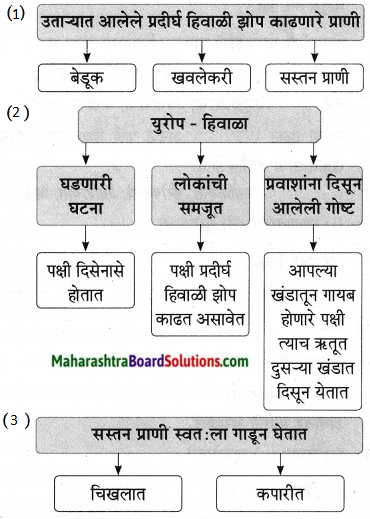
प्रश्न 2.
उत्तरे लिहा.
उत्तर:

प्रश्न 3.
जोड्या जुळवा.
| ‘अ’ गट | ‘ब’ गट |
| 1. हिवाळी झोप काढणारे | (अ) पक्षी |
| 2. स्थलांतर करणारे | (ब) संस्था |
| 3. स्थलांतराचा अभ्यास करणाऱ्या | (क) सस्तन प्राणी |
| 4. अवघड प्रश्नातून मार्ग काढणारे | (ड) विज्ञान |
उत्तर:
| ‘अ’ गट | ‘ब’ गट |
| 1. हिवाळी झोप काढणारे | (क) सस्तन प्राणी |
| 2. स्थलांतर करणारे | (अ) पक्षी |
| 3. स्थलांतराचा अभ्यास करणाऱ्या | (ब) संस्था |
| 4. अवघड प्रश्नातून मार्ग काढणारे | (ड) विज्ञान |
![]()
खालील प्रश्नांची उत्तरे एका वाक्यात लिहा.
प्रश्न 1.
माणूस एका खंडातून दुसऱ्या खंडात प्रवास करू लागला तेव्हा त्याच्या काय लक्षात आले?
उत्तरः
माणूस एका खंडातून दुसऱ्या खंडात प्रवास करू लागला तेव्हा त्याच्या लक्षात आले की, आपल्या खंडातून गायब होणारे पक्षी त्याच ऋतूत दुसऱ्या खंडात दिसून येतात.
प्रश्न 2.
पक्ष्यांच्या पायाला लावण्यात येणारे वाळे कोणत्या धातूचे असतात?
उत्तरः
पक्ष्यांच्या पायाला लावण्यात येणारे वाळे अल्युमिनिअम या धातूचे असतात.
प्रश्न 3.
कंसातील योग्य शब्द वापरून रिकाम्या जागा भरा.
1. पक्ष्यांच्या ………… अभ्यास करणे ही काही सोपी गोष्ट नाही. (कालांतराचा, उपयोगांचा, वाढीचा, स्थलांतराचा)
2. याच्या उलट ………….. अनेक पक्षी हिवाळ्यात दिसेनासे होतात याची जाणीव होती. (आफ्रिकेत, युरोपमध्ये, आशियात, अमेरिकेत)
उत्तर:
1. स्थलांतराचा
2. युरोपमध्ये
प्रश्न 4.
सहसंबंध लिहा.
अनेक : पक्षी :: खुणेचे : ……………….
उत्तर:
वाळे
प्रश्न 5.
शब्दसमूहांसाठी एक शब्द लिहा.
1. पिलांना जन्म देणारे
2. अंगावर खवले असणारे
उत्तर:
1. सस्तन
2. खवलेकरी
![]()
प्रश्न 6.
आकृतिबंध पूर्ण करा.
उत्तर:

कृती 2: आकलन कृती
प्रश्न 1.
योग्य पर्याय निवडून विधान पूर्ण करा.
पक्ष्यांच्या स्थलांतराचा अभ्यास करणे ही ………………
(अ) काही साधी गोष्ट नाही.
(ब) काही अवघड गोष्ट नाही.
(क) अवघड गोष्ट आहे.
(ड) काही सोपी गोष्ट नाही
उत्तरः
पक्ष्यांच्या स्थलांतराचा अभ्यास करणे ही काही सोपी गोष्ट नाही.
प्रश्न 2.
कोण ते लिहा.
हिवाळ्यात प्रदीर्घ झोप काढणारे प्राणी
उत्तर:
बेडूक, खवलेकरी, सस्तन प्राणी
प्रश्न 3.
आकृतिबंध पूर्ण करा.
उत्तर:
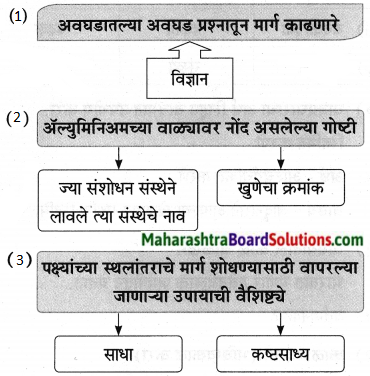
प्रश्न 4.
चूक की बरोबर लिहा.
1. पक्ष्यांच्या स्थलांतराचा अभ्यास करणे ही सोपी गोष्ट आहे.
2. अल्युमिनिअमचे बनवलेले हे वाळे जड असतात.
उत्तर:
1. चूक
2. चूक
![]()
कृती 3: व्याकरण कृती
खालील वाक्ये लेखननियमांनुसार शुद्ध करून लिहा.
प्रश्न 1.
पक्षांच्या स्तलांतराचा अभ्यास करणे ही काही सोपी गोष्ट नाही.
उत्तरः
पक्ष्यांच्या स्थलांतराचा अभ्यास करणे ही काही सोपी गोष्ट नाही.
प्रश्न 2.
त्याचे पक्षांना ओजे होत नाही.
उत्तरः
त्याचे पक्ष्यांना ओझे होत नाही.
प्रश्न 3.
उताऱ्यातील नामे शोधून लिहा.
उत्तर:
- युरोप
- पक्षी
- हिवाळा
- बर्फ
- बेडूक
- प्राणी
- चिखल
- माणूस
- खंड
- ऋतू
- विज्ञान
प्रश्न 4.
अचूक शब्द लिहा.
1. प्राण्यांप्रमाणे, प्राणांप्रमाणे, प्राण्याप्रमाणे, प्रांण्याप्रमाणे
2. स्थलातर, स्तलांतर, स्थळांतर, स्थलांतर
उत्तर:
1. प्राण्यांप्रमाणे
2. स्थलांतर
प्रश्न 5.
समानार्थी शब्द लिहा.
उत्तर:
- दिसेनासे – गायब
- मेहनत – कष्ट
- पारख – जाणीव
- लांबलचक – प्रदीर्घ
![]()
प्रश्न 6.
विरुद्धार्थी शब्द लिहा.
उत्तर:
- सुलट × उलट
- अवघड × सोपी
- जड × हलके
- निरुपाय × उपाय
प्रश्न 7.
अधोरेखित शब्दाचा समानार्थी शब्द वापरून वाक्य पुन्हा लिहा.
अवघड प्रश्नातून विज्ञानाला रस्ते काढावेच लागतात.
उत्तरः
अवघड प्रश्नातून विज्ञानाला मार्ग काढावेच लागतात.
अधोरेखित शब्दाची जात ओळखा.
प्रश्न 1.
त्याचे पक्ष्यांना ओझे होत नाही.
उत्तरः
नाम.
प्रश्न 2.
या वाळ्यावर संस्थेचे नाव, खुणेचा क्रमांक असतो.
उत्तरः
शब्दयोगी अव्यय.
![]()
प्रश्न 9.
तक्ता पूर्ण करा.
उत्तरः
| शब्द | प्रत्यय | विभक्ती |
| खंडातून | ऊन | पंचमी (एकवचन) |
| पक्ष्यांच्या | च्या | षष्ठी (अनेकवचन |
| संस्थेने | न | तृतीया (एकवचन) |
| खुणेचा | चा | षष्ठी (एकवचन) |
प्रश्न 10.
तक्ता पूर्ण करा.
उत्तरः
| शब्द | सामान्यरूप | मूळ शब्द |
| 1. चिखलात | चिखला | चिखल |
| 2. खंडात | खंडा | खंड |
| 3. ऋतूत | ऋतू | ऋतू |
| 4. खुणेचा | खूण | ऊन |
प्रश्न 11.
वाक्प्रचाराचा अर्थ लिहून वाक्यात उपयोग करा.
दिसेनासे होणे – नाहीसे होणे
उत्तरः
वाक्य – भारतात अनेक जातींचे पक्षी दिसेनासे होत आहेत.
प्रश्न 12.
वाक्यातील काळ ओळखा.
एक साधा पण कष्टसाध्य उपाय गेल्या शतकापासून वापरला जात आहे.
उत्तरः
वर्तमानकाळ
![]()
प्रश्न 13.
काळ बदला. (भूतकाळ करा)
कोणत्या क्रमांकाचे वाळे कोणत्या पक्ष्याला, कुठे आणि केव्हा लावले यांची संस्थेकडे नोंद असते.
उत्तरः
कोणत्या क्रमांकाचे वाळे कोणत्या पक्ष्याला, कुठे आणि केव्हा लावले यांची संस्थेकडे नोंद होती.
प्रश्न 14.
पर्यायी शब्द लिहा.
उत्तरः
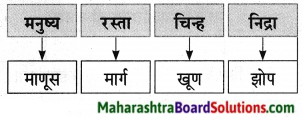
कृती 4: स्वमत
प्रश्न 1.
तुम्हांला पक्षिमित्र बनायला आवडेल काय? तुमचे मत सकारण लिहा.
उत्तरः
होय, मला पक्षिमित्र बनायला आवडेल. मला 0पक्षी फार आवडतात. तासन्तास कर्नाळा अभयारण्यात जाऊन तेथील पक्षी पाहण्यास मला फार आवडते. माझ्याकडे अनेक पक्ष्यांची चित्रे आहेत. मी स्वत: डॉ. सलीम अली यांचे पक्षी-वर्णन वाचलेले आहे. त्यामुळे मला पक्षिमित्र बनायला आवडेल. पक्षिमित्र बन्न जंगलात भ्रमंती करून पक्ष्यांचा स्वच्छंद कलरव कानी ऐकताना एक वेगळ्याच प्रकारची सुंदर अनुभूती येते याचा प्रत्यक्ष अनुभव मी घेतलेला आहे. पक्षिमित्र बनून मी पक्ष्यांचे संवर्धन करण्याचे उपक्रम हाती घेईन. समाजात पक्ष्यांबद्दल प्रेम व जागरुकता निर्माण करीन. मला नक्कीच पक्षिमित्र बनायला आवडेल.
पुढील उताऱ्याच्या आधारे दिलेल्या सूचनेनुसार कृती करा:
कृती 1: आकलन कृती
प्रश्न 1.
आकृतिबंध पूर्ण करा.
उत्तरः


प्रश्न 2.
उत्तरे लिहा.
उत्तरः

प्रश्न 3.
जोड्या जुळवा.
| ‘अ’ गट | ‘ब’ गट |
| 1. केरळ | (अ) पक्ष्यांच्या स्थलांतराविषयी माहिती |
| 2. रडारयंत्रणा | (ब) बलाक |
| 3. जर्मनी | (क) रानपरीट |
| 4. वाळे अडकवलेले | (ड) पक्षी |
उत्तरः
| ‘अ’ गट | ‘ब’ गट |
| 1. केरळ | (क) रानपरीट |
| 2. रडारयंत्रणा | (अ) पक्ष्यांच्या स्थलांतराविषयी माहिती |
| 3. जर्मनी | (ब) बलाक |
| 4. वाळे अडकवलेले | (ड) पक्षी |
![]()
खालील प्रश्नांची उत्तरे एका वाक्यात लिहा.
प्रश्न 1.
ब्रह्मदेशात सापडलेला रानपरीट मुळात कोठे आढळतो?
उत्तर:
ब्रह्मदेशात सापडलेला रानपरीट मुळात केरळात आढळतो.
प्रश्न 2.
केरळात वाळे लावलेले परीट पक्षी कोणत्या भागांत सापडले आहेत?
उत्तरः
केरळात वाळे लावलेले परीट पक्षी काबूल, अफगाणिस्तान, वायव्य पाकिस्तान या भागांत सापडले आहेत.
प्रश्न 3.
कंसातील योग्य शब्द वापरून रिकाम्या जागा भरा.
1. ………….. वाळे लावलेला बलाक बिकानेरमध्ये सापडला…. (ऑस्ट्रेलियात, जर्मनीत, रशियात, अमेरिकेत)
2. अलीकडच्या काळात …………. आणि रडारयंत्रणामुळे सुद्धा पक्ष्यांच्या स्थलांतराविषयी मोलाची माहिती मिळाली आहे. (विमाने, बोटी, पाणबुड्या, रेल्वे)
उत्तर:
1. जर्मनीत
2. विमाने
प्रश्न 4.
सहसंबंध लिहा.
रानपरीट : ब्रह्मदेश :: बलाक : ………..
उत्तर:
बिकानेर
कृती 2: आकलन कृती
प्रश्न 1.
योग्य पर्याय निवडून विधान पूर्ण करा.
एखादा वाळे असलेला पक्षी जिवंत अथवा मृत ज्याला सापडेल त्याने …………….
(अ) त्याला धरावे अशी अपेक्षा असते.
(ब) त्याला सोडावे अशी अपेक्षा असते.
(क) त्या संस्थेला कळवावे अशी अपेक्षा असते.
(ड) त्या संस्थेला कळू देऊ नये अशी अपेक्षा असते.
उत्तरः
एखादा वाळे असलेला पक्षी जिवंत अथवा मृत ज्याला सापडेल त्याने त्या संस्थेला कळवावे अशी अपेक्षा असते.
प्रश्न 2.
कोण ते लिहा.
ब्रह्मदेशात सापडलेला पक्षी –
उत्तरः
रानपरीट
![]()
प्रश्न 3.
आकृतिबंध पूर्ण करा.
उत्तरः
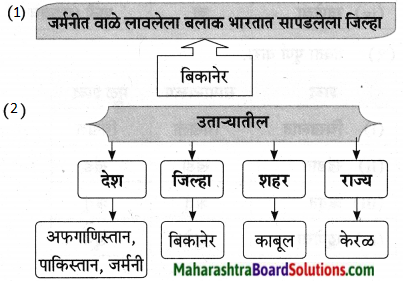
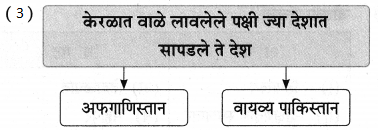
प्रश्न 4.
सत्य वा असत्य ते लिहा.
1. वाळे अडकवलेले पक्षी पुन्हा मोकळे सोडले जातात.
2. केरळातलाच एक रानपरीट नेपाळमध्ये सापडला आहे.
उत्तर:
1. सत्य
2. असत्य
कृती 3: व्याकरण कृती
प्रश्न 1.
खालील वाक्य लेखननियमांनुसार शुद्ध करून लिहा.
अरथात लावलेल्या सर्व वाळ्याची माहिती परत मिळतेच असे नाही.
उत्तरः
अर्थात लावलेल्या सर्व वाळ्यांची माहिती परत मिळतेच असे नाही.
प्रश्न 2.
उताऱ्यातील विशेषणे शोधून लिहा.
उत्तर:
- जिवंत
- मृत
- मौल्यवान
- मोलाची
- एक
- दोना
प्रश्न 3.
अचूक शब्द लिहा.
1. मैल्यवान, मोल्यवान, मौलवान, मौल्यवान
2. कीत्येक, कितेक, कित्येक, कीतेक
उत्तर:
1. मौल्यवान
2. कित्येक
![]()
प्रश्न 4.
समानार्थी शब्द लिहा.
उत्तर:
- किमती – मौल्यवान
- प्रदेश – प्रांत
- रहस्य – गूढ
- आकांक्षा – अपेक्षा
प्रश्न 5.
खालील वाक्यातील अधोरेखित शब्दाचे वचन बदलून वाक्य पुन्हा लिहा.
वाळे अडकवलेले हे पक्षी पुन्हा मोकळे सोडले जातात.
उत्तरः
वाळे अडकवलेला हा पक्षी पुन्हा मोकळा सोडला जातो.
प्रश्न 6.
विरुद्धार्थी शब्द लिहा.
उत्तरः
- बंदिस्त × मोकळे
- हरवणे × सापडणे
- जिवंत × मृत
- तुच्छ × मौल्यवान
प्रश्न 7.
खालील वाक्यातील अधोरेखित शब्दाचा समानार्थी शब्द लिहून वाक्य पुन्हा लिहा.
शंभरातल्या एक दोन वाळ्यांचा जरी ठिकाणा लागला तरी त्यातून मौल्यवान माहिती मिळू शकते.
उत्तरः
शंभरातल्या एक दोन वाळ्यांचा जरी पत्ता लागला तरी त्यातून मौल्यवान माहिती मिळू शकते.
प्रश्न 8.
उताऱ्यातील अनेकवचनी शब्द शोधून लिहा.
उत्तर:
- वाळे
- रहस्ये
- पक्षी
![]()
प्रश्न 9.
तक्ता पूर्ण करा.
उत्तर:
| शब्द | प्रत्यय | विभक्ती |
| 1. वाळ्यांची | ची | षष्ठी (अनेकवचन) |
| 2. मोलाची | ची | षष्ठी (एकवचन) |
| 3. संख्येला | ला | द्वितीया (एकवचन) |
| 4. ब्रह्मदेशात | त | सप्तमी (एकवचन) |
प्रश्न 10.
तक्ता पूर्ण करा.
उत्तर:
| शब्द | सामान्यरूप | मूळ शब्द |
| 1. संस्थेला | संस्थे | संस्था |
| 2. पक्ष्यांच्या | पक्ष्यां | पक्षी |
| 3. मोलाची | मोला | मोल |
| 4. वाळ्यांचा | वाळ्या | वाळे |
प्रश्न 11.
काळ बदला. (भूतकाळ करा)
जर्मनीत वाळे लावलेला बलाक बिकानरेमध्ये सापडला आहे.
उत्तरः
जर्मनीत वाळे लावलेला बलाक बिकानेरमध्ये सापडला होता.
प्रश्न 12.
पर्यायी शब्द लिहा.
उत्तरः

कृती 4: स्वमत
प्रश्न 1.
पक्षी निरीक्षणातून पक्ष्यांच्या जीवनपद्धतीसंबंधी तुमचे मत सविस्तर लिहा.
उत्तर:
पक्षी एका ठिकाणाहून दुसऱ्या ठिकाणी स्थलांतर करतात. हवामानानुसार व अन्नाच्या शोधासाठी पक्षी एका ठिकाणाहून दुसऱ्या ठिकाणी जातात. अधिकाधिक पक्षी आपआपल्या थव्यांमध्येच राहणे पसंत करतात. विशेषत: चिमण्या, कावळे, कबूतरे, राजहंस, बगळे आपआपल्या थव्यांमध्येच राहणे पसंत करतात. खरे पाहायला गेले तर पक्ष्यांना हवामानाची एवढी चिंता नसते. ते कोणत्याही प्रदेशात राहू शकतात. जर का एखादया प्रदेशात पुरेसे अन्न उपलब्ध नसेल तर पक्षी तो प्रदेश सोडून दुसऱ्या प्रदेशात स्थलांतरित होतात. पक्षी पर्यावरणाचा एक अविभाज्य भाग असतात. पर्यावरणातील कचरा, मानवाने टाकलेल्या टाकाऊ वस्तू खाऊनच ते आपला उदरनिर्वाह करीत असतात. एका अर्थाने ते पर्यावरण स्वच्छ ठेवण्याच्या कामी मानवाची मदतच करीत असतात.
![]()
पुढील उताऱ्याच्या आधारे दिलेल्या सूचनेनुसार कृती करा:
कृती 1: आकलन कृती
प्रश्न 1.
आकृतिबंध पूर्ण करा.
उत्तर:

प्रश्न 2.
उत्तरे लिहा.
उत्तर:
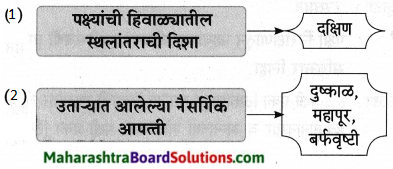
प्रश्न 3.
जोड्या जुळवा.
| ‘अ’ गट | ‘ब’ गट |
| 1. हिमालय | (अ) हिवाळ्यात |
| 2. दक्षिणेकडे स्थलांतर | (ब) महापूर |
| 3. मूळ प्रेरणा | (क) पर्वतरांगा |
| 4. नैसर्गिक आपत्ती | (ड) स्थलांतरामागची |
उत्तर:
| ‘अ’ गट | ‘ब’ गट |
| 1. हिमालय | (क) पर्वतरांगा |
| 2. दक्षिणेकडे स्थलांतर | (अ) हिवाळ्यात |
| 3. मूळ प्रेरणा | (ड) स्थलांतरामागची |
| 4. नैसर्गिक आपत्ती | (ब) महापूर |
![]()
खालील प्रश्नांची उत्तरे एका वाक्यात लिहा.
प्रश्न 1.
हिमालय पर्वतरांगांमधील पक्षी हिवाळ्यात कुठे जातात?
उत्तरः
हिमालय पर्वरांगांमधील पक्षी हिवाळ्यात सखल भागात जातात.
प्रश्न 2.
स्थलांतरामागची मूळ प्रेरणा कोणती?
उत्तरः
अन्नाचे दुर्भिक्ष हीच स्थलांतरामागची मूळ प्रेरणा आहे.
प्रश्न 3.
पक्ष्यांना कशाची फारशी काळजी नसते?
उत्तरः
पक्ष्यांना थंडीवाऱ्याची फारशी काळजी नसते.
प्रश्न 4.
कोणते पक्षी सत्तावीस हजार फुटांपर्यंत आल्याची नोंद आहे?
उत्तर:
हिमकाक पक्षी सत्तावीस हजार फुटांपर्यंत आल्याची नोंद आहे.
प्रश्न 5.
कंसातील योग्य शब्द वापरून रिकामी जागा भरा.
उत्तर:
मुळात अन्नाचे दुर्भिक्ष हीच …………………. मूळ प्रेरणा आहे.
(स्थलांतरामागची, प्रवासामागची, उडण्यामागची, शोधण्यामागची)
उत्तरः
स्थलांतरामागची
प्रश्न 6.
सहसंबंध लिहा.
उंच : सखल :: सोपे : ………..
उत्तरः
कठीण
कृती 2: आकलन कृती
योग्य पर्याय निवडून विधाने पूर्ण करा.
प्रश्न 1.
पक्षी तो प्रांत सोडून तात्पुरते दुसरीकडे जातात; कारण
(अ) एकाच ठिकाणी राहण्याचा कंटाळा आला की.
(ब) एकाच प्रकारचे अन्न खाल्ले की.
(क) अन्न मिळेनासे झाले की.
(ड) अन्नामध्ये वैविध्य नसले की.
उत्तर:
पक्षी तो प्रांत सोडून तात्पुरते दुसरीकडे जातात; कारण अन्न मिळेनासे झाले की.
प्रश्न 2.
अन्नाचा पुरेसा पुरवठा असेल तर ………………
(अ) पक्षी अन्न शोधत नाहीत.
(ब) पक्षी आळशी होतात.
(क) पक्षी बर्फाळ प्रांतातही व्यवस्थित जगू शकतात.
(ड) पक्षी बर्फाळ प्रांतातही व्यवस्थित जगू शकत नाहीत.
उत्तर:
अन्नाचा पुरेसा पुरवठा असेल तर पक्षी बर्फाळ प्रांतातही व्यवस्थित जगू शकतात.
![]()
कोण ते लिहा.
प्रश्न 1.
उताऱ्यात आलेल्या पर्वतरांगा –
उत्तर:
हिमालय
प्रश्न 2.
सत्तावीस हजार फुटांपर्यंत आढळणारा पक्षी –
उत्तर:
हिमकाक पक्षी
प्रश्न 3.
आकृतिबंध पूर्ण करा.
उत्तर:

प्रश्न 4.
आकृतिबंध पूर्ण करा.
उत्तर:

प्रश्न 5.
चूक की बरोबर लिहा.
1. हिवाळ्यात पक्षी उत्तरेकडे स्थलांतर करतात.
2. पक्ष्यांना थंडीवाऱ्याची फार काळजी असते.
उत्तर:
1. चूक
2. चूक
कृती 3: व्याकरण कृती
प्रश्न 1.
खालील वाक्य लेखननियमांनुसार शुद्ध करून लिहा. त्यांच्या एकूण परवास काही कीलोमीटरचाच असतो.
उत्तरः
त्यांचा एकूण प्रवास काही किलोमीटरचाच असतो.
प्रश्न 2.
उताऱ्यातील विशेषणे शोधून लिहा.
उत्तर:
- एकूण
- मूळ
- फारशी
- पुरेसा
- व्यवस्थित
![]()
प्रश्न 3.
अचूक शब्द लिहा.
1. दुष्काळ, दुश्काळ, दूष्काळ, दूश्काळ
2. महापुर, माहापूर, महापूर, माहापुर
उत्तर:
1. दुष्काळ
2. महापूर
प्रश्न 4.
समानार्थी शब्द लिहा.
उत्तर:
- टंचाई – [दुर्भिक्ष]
- प्रोत्साहन – [प्रेरणा]
- अवघड – [कठीण]
- चिंता – [काळजी]
प्रश्न 5.
विरुद्धार्थी शब्द लिहा.
उत्तर:
- वर × [खाली]
- सुकाळ × [दुष्काळ]
- कायमचे × [तात्पुरते]
- अव्यवस्थित × [व्यवस्थित]
प्रश्न 6.
उताऱ्यातील दोन अनेकवचनी शब्द शोधून लिहा.
उत्तर:
1. पर्वतरांगा
2. पक्षी
प्रश्न 7.
तक्ता पूर्ण करा.
उत्तर:
| शब्द | प्रत्यय | विभक्ती |
| 1. दरीत | त | सप्तमी (एकवचन) |
| 2. अन्नाचे | चे | षष्ठी (एकवचन) |
प्रश्न 8.
तक्ता पूर्ण करा.
उत्तर:
| शब्द | सामान्यरूप | मूळ शब्द |
| 1. पक्ष्यांचा | पक्ष्यां | पक्षी |
| 2. अन्नाचे | अन्ना | अन्न |
| 3. थंडीवाऱ्याची | थंडीवाऱ्या | थंडीवारा |
| 4. उन्हाळ्यात | उन्हाळ्या | उन्हाळा |
प्रश्न 9.
वाक्यातील काळ ओळखा.
मुळात अन्नाचे दुर्भिक्ष हीच स्थलांतरामागची मूळ प्रेरणा आहे.
उत्तरः
वर्तमानकाळ.
प्रश्न 10.
काळ बदला. (भविष्यकाळ करा)
पक्षी तो प्रांत सोडून तात्पुरते दुसरीकडे जातात.
उत्तर:
पक्षी तो प्रांत सोडून तात्पुरते दुसरीकडे जातील.
![]()
प्रश्न 11.
सहसंबंध लिहा.
हिमालय : नाम : : फारशी : . ……..
उत्तर:
विशेषण
प्रश्न 12.
पर्यायी शब्द लिहा.
उत्तर:

कृती 4: स्वमत
प्रश्न 1.
तुमच्या मते मानवी जीवन व पक्षी जीवन यांच्यातील महत्त्वाचे साधर्म्य सोदाहरण स्पष्ट करा.
उत्तर:
पक्ष्यांचे जीवन असो वा मानवाचे. दोघांनाही जीवन जगण्यास अन्नाची गरज असते. ज्या प्रदेशात जमीन सुपीक असते व पाण्याचा पुरवठा उपलब्ध असतो, तेथे मानवी जीवन निर्माण होते. त्याचप्रमाणे पक्ष्यांचेही तसेच असते. सुपीक जमिनीवर अनेक झाडे असतात. तसेच अन्नधान्य मुबलक प्रमाणात असते म्हणून पक्षीही अशाच प्रदेशात आपला तळ ठोकतात. एखादया प्रदेशात दुष्काळ, महापूर अथवा बर्फवृष्टी झाली की मानवी जीवन तेथून स्थलांतर करते तसेच पक्षीही मानवाचे अनुकरण करतात. हेच मानवी जीवन व पक्षी जीवन यांच्यातील महत्त्वाचे साधर्म्य आहे.
पुढील उताऱ्याच्या आधारे दिलेल्या सूचनेनुसार कृती करा:
कृती 1: आकलन कृती
प्रश्न 1.
आकृतिबंध पूर्ण करा.
उत्तर:
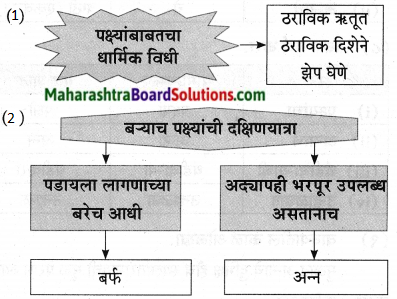
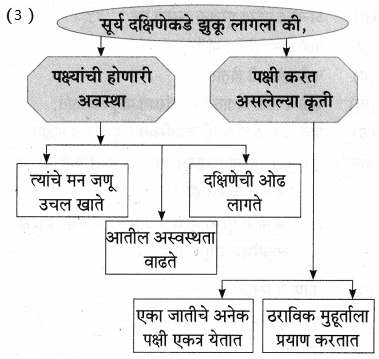
प्रश्न 2.
उत्तरे लिहा.
उत्तर:

प्रश्न 3.
जोड्या जुळवा.
| ‘अ’ गट | ‘ब’ गट |
| 1. अनेक | (अ) अन्नाचा |
| 2. तुटवडा | (ब) पक्षी |
| 3. धार्मिक | (क) ओढ |
| 4. अनामिक | (ड) विधी |
उत्तर:
| ‘अ’ गट | ‘ब’ गट |
| 1. अनेक | (ब) पक्षी |
| 2.तुटवडा | (अ) अन्नाचा |
| 3. धार्मिक | (ड) विधी |
| 4. अनामिक | (क) ओढ |
![]()
प्रश्न 4.
उताऱ्यानुसार घटनांचा क्रम लावा.
- ठराविक मुहूर्ताला पक्षी प्रयाण करतात.
- सूर्य दक्षिणेकडे झुकू लागतो.
- एका जातीचे अनेक पक्षी एकत्र येतात.
- त्यांचे मन जणू उचल खाते.
उत्तर:
- सूर्य दक्षिणेकडे झुकू लागतो.
- त्यांचे मन जणू उचल खाते.
- एका जातीचे अनेक पक्षी एकत्र येतात.
- ठराविक मुहूर्ताला पक्षी प्रयाण करतात.
खालील प्रश्नांची उत्तरे एका वाक्यात लिहा.
प्रश्न 1.
पक्षी केव्हा आपल्या उत्तरेतल्या घरांकडे निघतात?
उत्तरः
वसंतागमाला पक्षी आपल्या उत्तरेतल्या घरांकडे निघतात.
प्रश्न 2.
पक्ष्यांचे मन केव्हा उचल खाते?
उत्तरः
सूर्य दक्षिणेकडे झुकू लागला, की पक्ष्यांचे मन उचल खाते.
कंसातील योग्य शब्द वापरून रिकाम्या जागा भरा.
प्रश्न 1.
1. एका …………………. अनेक पक्षी एकत्र येतात. (जातीचे, वंशाचे, रंगाचे, आकाराचे)
2. ठराविक ऋतूत ठराविक दिशेन झेप घेणे हा एक …………………….. विधी’ असल्यासारखा त्यांच्या जीवनाचाच एक भाग झाला आहे. (पारंपरिक, अध्यात्मिक, धार्मिक, विधिवत)
3. ………….. सगळेच पक्षी अनामिक ओढीने आपल्या उत्तरेतल्या घरांकडे निघतात. (उन्हाळ्यात, पावसाळ्यात, वसंतागमाला, ग्रीष्मागमाला)
उत्तर:
1. जातीचे
2. धार्मिक
3. वसंतागमाला
सहसंबंध लिहा.
प्रश्न 1.
1. दक्षिणेकडे झुकू लागतो : सूर्य : : उचल खाते : ………………………
2. दक्षिणेकडे स्थलांतर : हिवाळ्यात :: परतीचा प्रवास : ………………
उत्तर:
1. मन
2. वसंतागमाला
कृती 2: आकलन कृती
प्रश्न 1.
योग्य पर्याय निवडून विधान पूर्ण करा.
त्यांचे मन जणू उचल खाते; ………..
(अ) सूर्य उत्तरेकडे झुकू लागली की.
(ब) सूर्य पश्चिमेकडे झुकू लागला की.
(क) सूर्य दक्षिणेकडे झुकू लागला की.
(ड) सूर्य पूर्वेकडे झुकू लागला की.
उत्तरः
त्यांचे मन जणू उचल खाते, सूर्य दक्षिणेकडे झुकू लागला की.
![]()
कोण ते लिहा.
प्रश्न 1.
दक्षिणेकडे झुकू लागणारा
उत्तरः
सूर्य
प्रश्न 2.
वसंतागमाला उत्तरेतल्या घरांकडे निघणारे
उत्तर:
पक्षी
प्रश्न 3.
आकृतिबंध पूर्ण करा.
उत्तर:
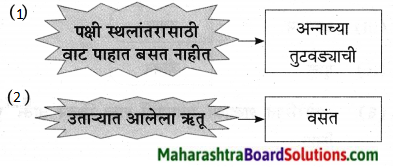
प्रश्न 4.
सत्य की असत्य ते लिहा.
1. वसंतागमाला सगळेच पक्षी अनामिक ओढीने आपल्या तल्या घरांकडे निघतात.
2. पक्षी स्थलांतरासाठी पाण्याच्या तुटवड्याची वाट पाहात बसत नाहीत.
उत्तर:
1. सत्य
2. असत्य
कृती 3: व्याकरण कृती
प्रश्न 1.
खालील वाक्ये लेखननियमांनुसार शुद्ध करून लिहा.
1. परतिच्या परवासाचेही तसेच.
2. आतिल अस्वस्तता वाढते.
उत्तर:
1. परतीच्या प्रवासाचेही तसेच.
2. आतील अस्वस्थता वाढते.
प्रश्न 2.
उताऱ्यातील नामे शोधून लिहा.
उत्तर:
- पक्षी
- बर्फ
- अन्न
- दक्षिण
- सूर्य
- वसंत
- उत्तर
- ऋतू
![]()
प्रश्न 3.
अचूक शब्द लिहा.
1. अमानिक, अमानीक, अनामिक, अनामीको
2. सबध, संबध, सबंधं, संबंध
उत्तर:
1. अनामिक
2. संबंध
प्रश्न 4.
समानार्थी शब्द लिहा.
उत्तर:
- विपुल – भरपूर
- प्रवास – यात्रा
- प्रस्थान – प्रयाण
- रवि – सूर्य
प्रश्न 5.
विरुद्धार्थी शब्द लिहा.
उत्तर:
- नंतर × आधी
- शवट × सुरुवात
- आगमन × प्रयाण
- मृत्यू × जीवन
प्रश्न 6.
अधोरेखित शब्दाचा समानार्थी शब्द लिहून वाक्य पुन्हा लिहा.
अन्नाच्या कमतरतेची वाट पाहात बसत नाहीत.
उत्तरः
अन्नाच्या तुटवड्याची वाट पहात बसत नाहीत.
प्रश्न 7.
तक्ता पूर्ण करा.
उत्तरः
| शब्द | प्रत्यय | विभक्ती |
| 1. स्थलांतराचा | चा | षष्ठी (एकवचन) |
| 2. अन्नाशी | शी | तृतीया (एकवचन) |
| 3. जातीचे | चे | षष्ठी (एकवचन) |
| 4. दिशेने | ने | तृतीया (एकवचन) |
प्रश्न 8.
तक्ता पूर्ण करा.
उत्तरः
| शब्द | सामान्यरूप | मूळ शब्द |
| 1. पक्ष्यांच्या | पक्ष्यां | पक्षी |
| 2. जातीचे | जाती | जात |
| 3. मुहूर्ताला | मुहूर्ता | मुहूर्त |
| 4. परतीच्या | परती | परत |
प्रश्न 9.
वाक्प्रचाराचा अर्थ लिहून वाक्यात उपयोग करा. झेप घेणे – उंच उडणे.
उत्तरः
पक्ष्याने भक्ष शोधण्यासाठी आकाशात झेप घेतली.
प्रश्न 10.
वाक्यातील काळ ओळखा. पक्ष्यांना थंडीवाऱ्याची फारशी काळजी नसते.
उत्तरः
वर्तमानकाळ.
![]()
प्रश्न 11.
पर्यायी शब्द लिहा.
उत्तरः

कृती 4: स्वमत
प्रश्न 1.
पक्षी स्थलांतर का करत असावेत त्यावर तुमचे मत लिहा.
उत्तरः
पक्ष्यांच्या दुनियेत अनेक चमत्कारिक गोष्टी आहेत. त्यापैकी एक म्हणजे पक्षी करत असलेले स्थलांतर. हिवाळ्यात ध्रुवीय प्रदेशातील दिवस लहान होतो. त्यातच बर्फवृष्टीमुळे अनेक वनस्पती, कीटक बर्फाखाली जातात. त्यामुळे हे पक्षी अन्नाच्या शोधात, सुरक्षित प्रदेश शोधत स्थलांतर करतात. आपल्याकडे थंडी असली, तरी ध्रुवीय प्रदेशाच्या तुलनेत कमी असते. इथे या पक्षांना मुबलक प्रमाणात अन्न मिळते. आपल्याकडे काही काळापुरते दिसणारे हे पक्षी स्थलांतर करून आलेले असतात. काही काळ इथे थांबून परत आपआपल्या प्रदेशात जातात. परंतु काही पक्ष्यांच्या बाबतीत स्थलांतराचा अन्नाशी संबंध नसून ठराविक ऋतूत, ठराविक दिशेने झेप घेणे हा त्यांच्या जीवनाचाच एक भाग झाला आहे. पक्ष्यांचे स्थलांतर ही पक्षीजीवनामधील एक विलक्षण घटना आहे. पक्षी खादयासाठी, हवामान बदलामुळे तसेच पिल्लांच्या प्रशिक्षणासाठीही स्थलांतर करतात. सदा सर्वकाळ अनुकूल परिस्थिती लाभण्यासाठी वसतिस्थानात नियमितपणे आणि आलटून पालटून बदल करत असतात. हे वर्षानुवर्षे न चुकता घडत असते.
आभाळातल्या पाऊलवाटा Summary in Marathi
प्रस्तावना:
नैसर्गिक साधनसंपत्तीने समृद्ध असलेल्या भारतात प्राणी, पक्षी यांमधील वैविध्यही थक्क करणारे आहे. भारतात पक्ष्यांच्या १२४६ जाती आहेत. पक्ष्यांच्या दुनियेतल्या अनेक आश्चर्यकारक गोष्टींपैकी एक गोष्ट म्हणजे पक्ष्यांचे स्थलांतर होय. पक्षी स्थलांतर का, कुठून व कधी करतात, याचे विवेचन प्रस्तुत पाठात आले आहे. प्रस्तुत पाठ ‘आपली सृष्टी आपले धन’ या पुस्तकातून घेतला आहे.
India is enriched with natural resources and also it has diversity of animals and birds. There are 1246 breeds of birds in India. Migration of birds is a marvel of bird-world. Explanation of why birds migrate, when and from where they migrate is found in this chapter. This chapter is taken from the book ‘Aapli Srushti Aaple Dhan’.
शब्दार्थ:
- पाऊलवाटा – पायवाटा, पदपथ (walking trails, footpath)
- समृद्ध – संपन्न (rich, prosperous)
- वैविध्य – विविधता, भिन्नता (variety, diversity)थक्क – चकित (surprised)
- स्थलांतर – जागेत बदल (migration)
- विवेचन – स्पष्टीकरण, चर्चा (explanation, discussion)
- स्तिमित – आश्चर्यचकित (astonished)
- मैल – अंतर मोजण्याचे एक माप (a mile)
- सरोवर – मोठे तळे, तलाव (a lake)
- श्वेत – सफेद (white)
- जाणीव – आकलन, ज्ञान, बोध (realization)
- सस्तन – पिल्लांना जन्म देणारे (mammal)
- कपार – गुंफा, विवर (a hole in a hill or rock)
- प्रदीर्घ – खूप लांब (very long, extensive)
- खंड – भूप्रदेश, अनेक देशांचा समुच्चय (a continent)
- वाळे – पायात घालण्याचा एक दागिना (an anklet)
- शतक – शंभर ही संख्या (century)
- मोलाची – महत्त्वाची (important)
- गूढ – रहस्य, गुपित (mystery, secret)
- उकलणे – उलगडा करणे (to expound)
- सखल – खोलगट (low land, depressed place)
- दुष्काळ – अन्नाची टंचाई (a drought)
- महापूर – नदीला येणारा मोठा पूर (great flood, deluge)
- दुर्भिक्ष – अभाव, दुष्काळ, कमतरता (scarcity, famine, dearth)
- गिर्यारोहक – डोंगर चढून जाणारा (mountaineer)
- घनता – दाटपणा (density, thickness)
- प्रयाण – गमन, प्रस्थान (departure)
- अनामिक – नावाचा उल्लेख नसलेला (nameless)
- ओढ – कल, आकर्षण (inclination, attraction)
![]()
टिपा:
- सायबेरिया – हा रशिया देशामधील एक अवाढव्य प्रदेश आहे. सायबेरियाने रशियाच्या एकूण क्षेत्रफळापैकी 77% भाग व्यापला आहे.
- कालिदास – हे एक शास्त्रीय संस्कृत भाषेतील सर्वात मोठे कवी व नाटककार होते. त्यांची नाटके आणि कविता या प्रामुख्याने भारतीय पुराणांवर आधारित आहेत.
- काबूल – अफगाणिस्तान देशाच्या राजधानीचे शहर.
- अफगाणिस्तान – दक्षिण-मध्य आशियातील एक देश.
- पाकिस्तान – दक्षिण आशियातील भारताच्या वायव्येकडील देश.
- परीट – (White Wagtail) हा स्थलांतरीत पक्षी आहे. हिवाळ्यात पाणथळ जागांजवळ हा पक्षी दिसतो.
- हिमालय – पृथ्वीवरील सर्वोच्च शिखरांचे माहेरघर. आशियातील पर्वतरांग ज्यामुळे भारतीय उपखंड तिबेटच्या पठारापासून वेगळे झाले आहे.
- हिमकाक पक्षी – (Red-billed Chough) कावळ्यांच्या जातीतील पक्षी जे पर्वत आणि किनाऱ्यालगतच्या शिखरांवर आढळतात.
- एव्हरेस्ट – समुद्रसपाटीपासून 8,848 मी. उंचीवरील जगातील सर्वोच्च शिखर.
- वसंत – भारतातील सहा ऋतूंपैकी एक ऋतू. हा फेब्रुवारी, मार्च व एप्रिल या महिन्यांमध्ये येतो.
वाक्प्रचार:
- 0स्तिमित करणे – आश्चर्यचकित करणे
- दिसेनासे होणे – नाहीसे होणे
- झेप घेणे – उंच उडणे
9th Std Marathi Questions And Answers:
